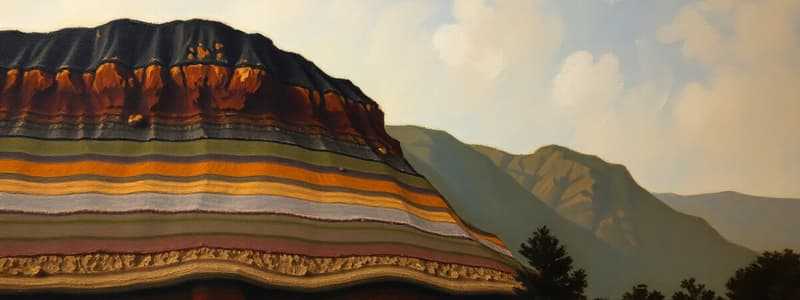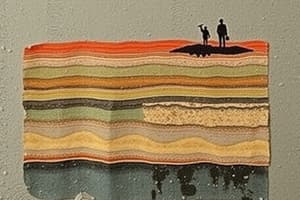Podcast
Questions and Answers
Which of these layers of the Earth is the thinnest?
Which of these layers of the Earth is the thinnest?
- Crust (correct)
- Mantle
- Outer Core
- Inner Core
The Earth's crust is a solid layer of rock that includes both dry land and the ocean floor.
The Earth's crust is a solid layer of rock that includes both dry land and the ocean floor.
True (A)
What are the two main types of rock that make up the Earth's crust?
What are the two main types of rock that make up the Earth's crust?
Granite and basalt
The ______ is the hottest part of the Earth's mantle.
The ______ is the hottest part of the Earth's mantle.
Match the following Earth layers with their primary compositions:
Match the following Earth layers with their primary compositions:
What is the primary reason we cannot directly observe the Earth's interior?
What is the primary reason we cannot directly observe the Earth's interior?
The movement of liquid metal in the Earth's outer core is believed to generate Earth's magnetic field.
The movement of liquid metal in the Earth's outer core is believed to generate Earth's magnetic field.
What is the name of the molten rock that forms within the Earth's upper mantle?
What is the name of the molten rock that forms within the Earth's upper mantle?
The inner core of Earth is a solid mass primarily composed of iron and nickel.
The inner core of Earth is a solid mass primarily composed of iron and nickel.
Which of the following is NOT a component of Earth's biosphere?
Which of the following is NOT a component of Earth's biosphere?
The layer of Earth's atmosphere closest to the surface, where most weather occurs, is called the ______.
The layer of Earth's atmosphere closest to the surface, where most weather occurs, is called the ______.
What are the four main systems, or spheres, that Earth is classified into?
What are the four main systems, or spheres, that Earth is classified into?
Match the following rock types with their primary formation method:
Match the following rock types with their primary formation method:
Which of the following statements is TRUE about the hydrosphere?
Which of the following statements is TRUE about the hydrosphere?
What are the two main elements that make up the inner core of the Earth?
What are the two main elements that make up the inner core of the Earth?
The geosphere includes the Earth's crust, mantle, outer core, and inner core.
The geosphere includes the Earth's crust, mantle, outer core, and inner core.
Flashcards
Earth's Layers
Earth's Layers
Earth is divided into four layers: crust, mantle, outer core, and inner core.
Earth's Crust
Earth's Crust
The crust is the outermost layer of Earth, consisting of solid rock, both land and ocean floor.
Crust Composition
Crust Composition
Oceanic crust is basalt; continental crust is primarily granite.
Crust Thickness
Crust Thickness
Signup and view all the flashcards
Earth's Mantle
Earth's Mantle
Signup and view all the flashcards
Magma Formation
Magma Formation
Signup and view all the flashcards
Outer Core
Outer Core
Signup and view all the flashcards
Earth's Magnetic Field
Earth's Magnetic Field
Signup and view all the flashcards
Inner Core
Inner Core
Signup and view all the flashcards
Earth's Spheres
Earth's Spheres
Signup and view all the flashcards
Biosphere
Biosphere
Signup and view all the flashcards
Hydrosphere
Hydrosphere
Signup and view all the flashcards
Geosphere
Geosphere
Signup and view all the flashcards
Sedimentary Rocks
Sedimentary Rocks
Signup and view all the flashcards
Atmosphere
Atmosphere
Signup and view all the flashcards
Troposphere
Troposphere
Signup and view all the flashcards
Study Notes
Earth's Layers
- Earth is divided into four layers: crust, mantle, outer core, and inner core
- Geologists use direct evidence (rock samples) and indirect evidence (seismic waves) to study Earth's interior
- Crust: Earth's outermost, solid layer; includes dry land and ocean floor. It's composed of granite (continental crust) and basalt (oceanic crust). It's the thinnest layer (5 to 70 km). Temperature varies (14 degrees Celsius average) and is the outermost layer.
- Mantle: Layer of hot, solid rock beneath the crust. The upper mantle is less rigid than the lower mantle. Magma forming in the upper mantle can rise to the surface and form volcanoes (thickness ~2,890 km, temperature 1,000-3,700 degrees Celsius).
- Outer core: Liquid layer of molten metal (mostly iron and nickel) below the mantle, believed to create Earth's magnetic field. It's malleable and stretches or bends, creating the magnetic field. (thickness ~2,260 km, temperature 4,500 - 5,500 Celsius)
- Inner core: Dense, solid metal sphere at the center of the Earth (mostly iron and nickel). High pressure prevents it from becoming liquid despite the high temperature. (thickness ~1,220 km, temperature 5,200 Celsius)
Rock Cycle
-
Rocks are classified into three main types: igneous, sedimentary, and metamorphic
-
Igneous rocks: Form when magma or lava cools and hardens. Extrusive igneous rocks cool quickly on Earth's surface, creating small crystals (e.g. pumice); Intrusive igneous rocks cool slowly, creating large crystals (e.g. granite).
-
Sedimentary rocks: Formed from particles of other rocks, cemented and compacted together by processes like weathering, erosion, and deposition.
-
Metamorphic rocks: Form under intense heat and pressure, changing the structure and minerals of existing rocks.
-
The rock cycle is a series of processes that transform rocks from one type to another (weathering, erosion, deposition, compaction, cementation).
Studying That Suits You
Use AI to generate personalized quizzes and flashcards to suit your learning preferences.




